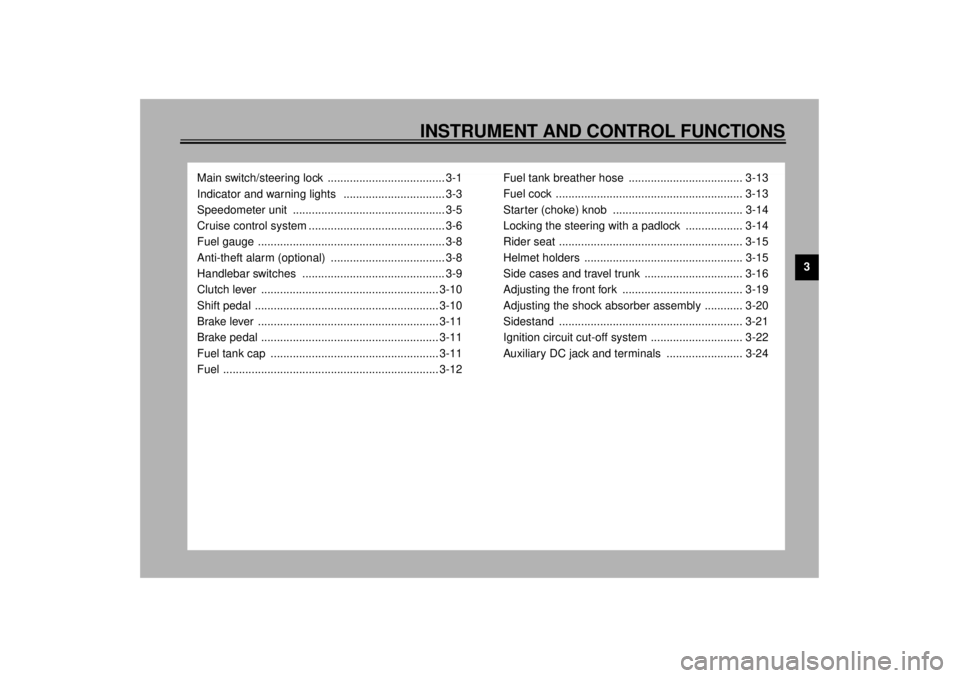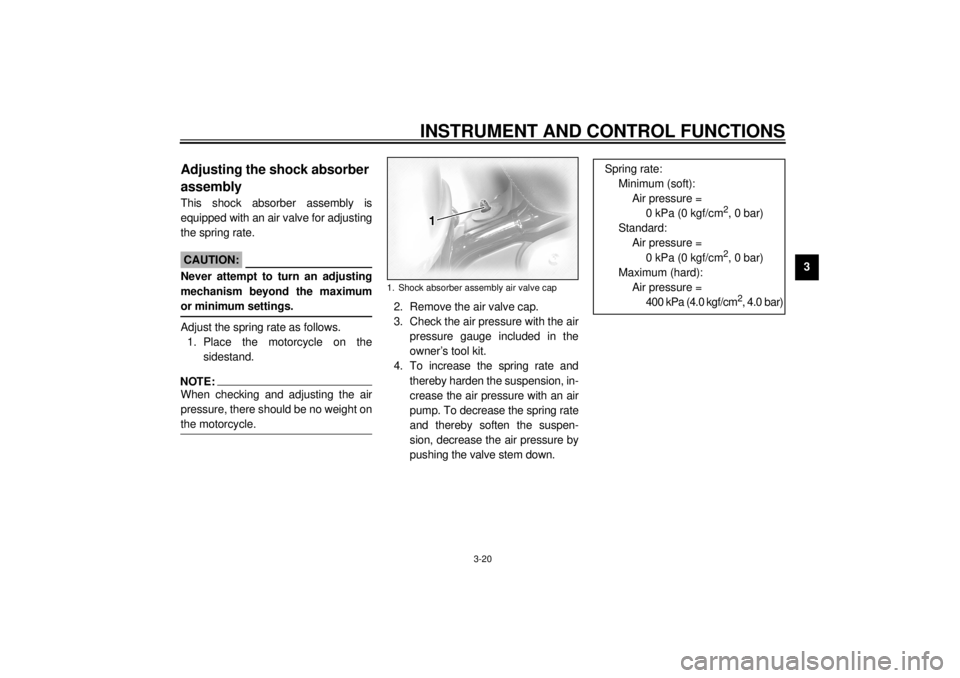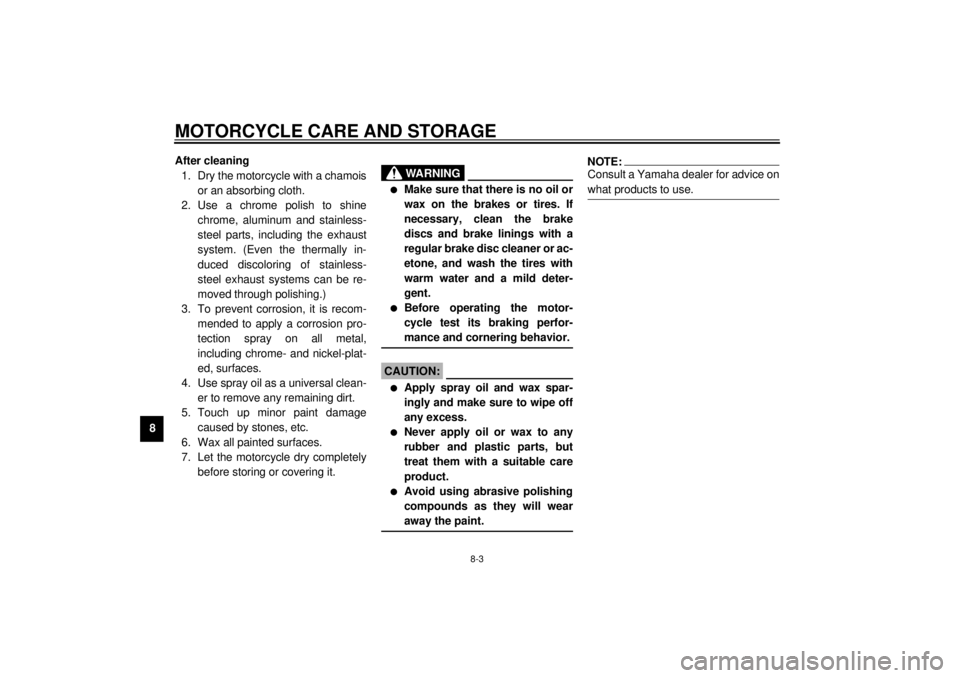2001 YAMAHA XVZ1300TF ABS
[x] Cancel search: ABSPage 13 of 132

DESCRIPTION
2-2
2
Right view12. Muffler
13. Owner’s tool kit (page 7-1)
14. Helmet holder (page 3-15)
15. Travel trunk (page 3-17)
16. Passenger seat
17. Shock absorber assembly air valve (page 3-20)
18. Rider seat (page 3-15)
19. Fuel tank (page 3-12)
20. Front fork air valve (page 3-19)21. Headlight (page 7-35)
22. Front turn signal lights (page 7-36)
23. Fuse box 1 (page 7-33)
24. Brake pedal (page 3-11)
25. Engine oil level check window (page 7-12)
26. Rider footrest
27. Coolant reservoir (page 7-15)
28. Passenger footrest
E_5jc.book Page 2 Monday, January 22, 2001 12:12 PM
Page 15 of 132

3
INSTRUMENT AND CONTROL FUNCTIONS
Main switch/steering lock ..................................... 3-1
Indicator and warning lights ................................ 3-3
Speedometer unit ................................................ 3-5
Cruise control system ........................................... 3-6
Fuel gauge ........................................................... 3-8
Anti-theft alarm (optional) .................................... 3-8
Handlebar switches ............................................. 3-9
Clutch lever ........................................................ 3-10
Shift pedal .......................................................... 3-10
Brake lever ......................................................... 3-11
Brake pedal ........................................................ 3-11
Fuel tank cap ..................................................... 3-11
Fuel .................................................................... 3-12Fuel tank breather hose .................................... 3-13
Fuel cock ........................................................... 3-13
Starter (choke) knob ......................................... 3-14
Locking the steering with a padlock .................. 3-14
Rider seat .......................................................... 3-15
Helmet holders .................................................. 3-15
Side cases and travel trunk ............................... 3-16
Adjusting the front fork ...................................... 3-19
Adjusting the shock absorber assembly ............ 3-20
Sidestand .......................................................... 3-21
Ignition circuit cut-off system ............................. 3-22
Auxiliary DC jack and terminals ........................ 3-24
E_5jc.book Page 1 Monday, January 22, 2001 12:12 PM
Page 35 of 132

INSTRUMENT AND CONTROL FUNCTIONS
3-20
3
EAU03721
Adjusting the shock absorber
assembly This shock absorber assembly is
equipped with an air valve for adjusting
the spring rate.
EC000015
CAUTION:_ Never attempt to turn an adjusting
mechanism beyond the maximum
or minimum settings. _Adjust the spring rate as follows.
1. Place the motorcycle on the
sidestand.NOTE:_ When checking and adjusting the air
pressure, there should be no weight on
the motorcycle. _
2. Remove the air valve cap.
3. Check the air pressure with the air
pressure gauge included in the
owner’s tool kit.
4. To increase the spring rate and
thereby harden the suspension, in-
crease the air pressure with an air
pump. To decrease the spring rate
and thereby soften the suspen-
sion, decrease the air pressure by
pushing the valve stem down.1. Shock absorber assembly air valve cap
Spring rate:
Minimum (soft):
Air pressure =
0 kPa (0 kgf/cm
2, 0 bar)
Standard:
Air pressure =
0 kPa (0 kgf/cm2, 0 bar)
Maximum (hard):
Air pressure =
400 kPa (4.0 kgf/cm2, 4.0 bar)
E_5jc.book Page 20 Monday, January 22, 2001 12:12 PM
Page 77 of 132

PERIODIC MAINTENANCE AND MINOR REPAIR
7-4
7
10
*Wheels• Check runout and for damage.ÖÖÖÖ
11*Tires• Check tread depth and for damage.
• Replace if necessary.
• Check air pressure.
• Correct if necessary.ÖÖÖÖ
12*Wheel bearings• Check bearing for looseness or damage.ÖÖÖÖ
13*Swingarm• Check operation and for excessive play.ÖÖÖÖ
• Lubricate with lithium-soap-based grease. Every 50,000 km
14*Steering bearings• Check bearing play and steering for roughness.ÖÖÖÖÖ
• Lubricate with lithium-soap-based grease. Every 50,000 km
15*Chassis fasteners• Make sure that all nuts, bolts and screws are properly tightened.ÖÖÖÖ Ö
16 Sidestand• Check operation.
• Lubricate.ÖÖÖÖ Ö
17*Sidestand switch• Check operation.ÖÖÖÖÖ Ö
18*Front fork• Check operation and for oil leakage.ÖÖÖÖ
19*Shock absorber
assembly• Check operation and shock absorber for oil leakage.ÖÖÖÖ
20*Rear suspension relay
arm and connecting arm
pivoting points• Check operation.ÖÖÖÖ
• Lubricate with lithium-soap-based grease.ÖÖ
21*Carburetors• Check starter (choke) operation.
• Adjust engine idling speed and synchronization.ÖÖÖÖÖ Ö
22 Engine oil• Change.ÖÖÖÖÖ Ö
23 Engine oil filter cartridge• Replace.ÖÖÖ
24*Cooling system• Check coolant level and vehicle for coolant leakage.ÖÖÖÖ Ö
• Change. Every 3 years NO. ITEM CHECK OR MAINTENANCE JOBODOMETER READING (´1,000 km)
ANNUAL
CHECK
1 10203040
E_5jc.book Page 4 Monday, January 22, 2001 12:12 PM
Page 116 of 132

MOTORCYCLE CARE AND STORAGE
8-3
8After cleaning
1. Dry the motorcycle with a chamois
or an absorbing cloth.
2. Use a chrome polish to shine
chrome, aluminum and stainless-
steel parts, including the exhaust
system. (Even the thermally in-
duced discoloring of stainless-
steel exhaust systems can be re-
moved through polishing.)
3. To prevent corrosion, it is recom-
mended to apply a corrosion pro-
tection spray on all metal,
including chrome- and nickel-plat-
ed, surfaces.
4. Use spray oil as a universal clean-
er to remove any remaining dirt.
5. Touch up minor paint damage
caused by stones, etc.
6. Wax all painted surfaces.
7. Let the motorcycle dry completely
before storing or covering it.
EWA00001
WARNING
_ l
Make sure that there is no oil or
wax on the brakes or tires. If
necessary, clean the brake
discs and brake linings with a
regular brake disc cleaner or ac-
etone, and wash the tires with
warm water and a mild deter-
gent.
l
Before operating the motor-
cycle test its braking perfor-
mance and cornering behavior.
_
ECA00013
CAUTION:_ l
Apply spray oil and wax spar-
ingly and make sure to wipe off
any excess.
l
Never apply oil or wax to any
rubber and plastic parts, but
treat them with a suitable care
product.
l
Avoid using abrasive polishing
compounds as they will wear
away the paint.
_
NOTE:_ Consult a Yamaha dealer for advice on
what products to use. _
E_5jc.book Page 3 Monday, January 22, 2001 12:12 PM
Page 122 of 132

SPECIFICATIONS
9-3
9
Maximum load* 190 kg
Tire air pressure
(measured on cold tires)
Up to 90 kg*
Front 250 kPa (2.50 kgf/cm
2, 2.50 bar)
Rear 250 kPa (2.50 kgf/cm2, 2.50 bar)
90 kg–maximum*
Front 250 kPa (2.50 kgf/cm2, 2.50 bar)
Rear 280 kPa (2.80 kgf/cm2, 2.80 bar)
* Total weight of rider, passenger, cargo and accessories
Wheels
Front
Type Cast wheel
Size 16 ´ MT 3.50
Rear
Type Cast wheel
Size 15M/C ´ MT 4.00
Brakes
Front
Type Dual disc brake
Operation Right hand
Fluid DOT 4Rear
Type Single disc brake
Operation Right foot
Fluid DOT 4
Suspension
Front Telescopic fork
Rear Swingarm (link suspension)
Spring/shock absorber
Front Coil-air spring / oil damper
Rear Coil-air spring / oil damper
Wheel travel
Front 140 mm
Rear 105 mm
Electrical
Ignition system T.C.I. (digital)
Charging system
Type A.C. magneto
Standard output 14 V, 29 A @ 5,000 r/min
Battery
Model YTX20L-BS
Voltage, capacity 12 V, 18 Ah
Headlight typeQuartz bulb (halogen)
E_5jc.book Page 3 Monday, January 22, 2001 12:12 PM
Page 129 of 132

INDEX
SSafety information.................................... 1-1
Shifting .................................................... 6-3
Shift pedal ............................................. 3-10
Shift points (for Switzerland only)............. 6-4
Shock absorber assembly, adjusting ..... 3-20
Side cases and travel trunk.................... 3-16
Sidestand .............................................. 3-21
Sidestand, checking and lubricating....... 7-30
Sound control unit.................................... 4-3
Spark plugs, checking ........................... 7-11
Specifications .......................................... 9-1
Speedometer unit .................................... 3-5
Starter (choke) knob .............................. 3-14
Starting a warm engine ............................ 6-3
Starting the engine .................................. 6-1
Start switch ............................................ 3-10
Steering, checking ................................. 7-31
Steering, locking with a padlock............. 3-14
Storage.................................................... 8-4TThrottle cable free play, adjusting .......... 7-21
Tires ...................................................... 7-21
Tool kit..................................................... 7-1
Troubleshooting..................................... 7-37
Troubleshooting charts .......................... 7-38
Turn signal indicator lights ....................... 3-3
Turn signal light or tail/brake light bulb,
replacing ............................................. 7-36
Turn signal switch .................................... 3-9
VValve clearance, adjusting .................... 7-21
Vehicle identification number................. 10-1WWheels .................................................. 7-24
E_5jc.book Page 2 Monday, January 22, 2001 12:12 PM